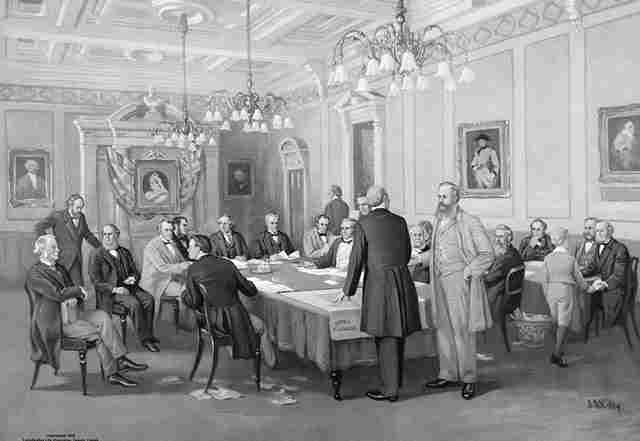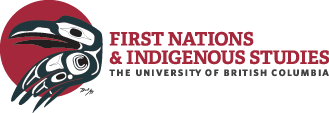
This painting depicts the drafting of the British North America Act in 1866. Painted in 1899 by John David Kelly. (c) 2007 Library and Archives Canada. Image courtesy of virtualmuseum.ca.
Canada and Aboriginal peoples continue to struggle with a history of legislation and policy designed to terminate Aboriginal cultural and social distinctiveness in order to assimilate Aboriginal peoples into colonial life and values. These efforts have persistently been resisted and challenged by Aboriginal peoples throughout their history, but because this policy and legislation has been so invasively enforced, it has nonetheless had a profound and frequently devastating impact on Aboriginal peoples.
The development of Canada was greatly facilitated by relations between Aboriginal and non-Aboriginal people. Aboriginal peoples were crucial to early European explorers’ survival in unfamiliar territories, and later were valuable military allies in wars between Canada and the United States in the 17th and 18th centuries. When these wars subsided and the United States and Canada worked towards creating and stabilizing unified nations. Greater numbers of settlers began to arrive, outnumbering Aboriginal people and settling in Aboriginal territories, frequently without Aboriginal peoples’ foreknowledge or consent despite agreements with colonial authorities guaranteeing their political autonomy and protection of their territories. Aboriginal peoples challenged the Canadian government to address these incursions, and as a result, the 18th and 19th centuries saw an array of legislation and policy around Aboriginal peoples.
This legislation was based on the assumption that in order to function within Canada, Aboriginal peoples needed to adopt a “Canadian” identity and abandon their cultures and traditions. Colonial thinking perceived Aboriginal peoples and cultures as “savage” and “primitive”, and ultimately unable to survive contemporary colonial society without the direct intervention and supervision of the Canadian government.
“Our Indian legislation generally rests on the principle, that the aborigines are to be kept in a condition of tutelage and treated as wards or children of the State. …the true interests of the aborigines and of the State alike require that every effort should be made to aid the Red man in lifting himself out of his condition of tutelage and dependence, and that is clearly our wisdom and our duty, through education and every other means, to prepare him for a higher civilization by encouraging him to assume the privileges and responsibilities of full citizenship.”
Department of the Interior,
Annual Report for the year ended 30th June, 1876
(Parliament, Sessional Papers, No. 11, 1877), p. xiv.
The history of government policy is not strictly a unilateral, top-down relationship—Aboriginal peoples have consistently responded to and actively resisted against it since its inception. In some instances, this resistance has managed to affect and shape some policy.
Regardless, the colonial origins of Aboriginal policy and legislation continue to inform the relationship between the Canadian government and Aboriginal peoples, and the contemporary social realities of Aboriginal people in Canada.
In this section:
In order to develop an understanding of the relationship between the Canadian government and Aboriginal peoples, and how government policy continues to be an invasive force on Aboriginal peoples today, we recommend the following sections:
- We begin with the Indian Act, and its equally invasive components, such as Indian status, bands, Bill C-31, and enfranchisement.
- Reserves are included within our section on government policy, as the reserve system was created by the government in an attempt to limit Aboriginal peoples’ movement and free up land for arriving settlers.
- The Residential School System refers to an extensive school system set up by the Canadian government and administered by churches that purported to educate Aboriginal children by removing them from their families and home communities, forbidding them to acknowledge their Aboriginal heritage, and indoctrinating them into Euro-Canadian and Christian ways of living to assimilate them into mainstream Canadian society. The last residential school closed its doors in the 1980s. The damaging and traumatic impacts of the residential school system continues to have lasting legacies on residential school survivors, their families and communities.
- The Sixties Scoop refers to the widespread removal of Aboriginal children from their families and home communities. Although it is commonly known as “the Sixties Scoop,” widespread “adopting-out” of Aboriginal children is still prevalent today.
- The Royal Proclamation of 1763 is perhaps the first colonial policy to mention Aboriginal peoples in what would become Canada. The Proclamation continues to influence policy and Aboriginal rights discourse today.
- The White Paper ,1969 was a policy the government proposed but later dropped due to widespread resistance from Aboriginal peoples and organizations across Canada.
- Section 35 of the Constitution Act, 1982 represents the inclusion of Aboriginal peoples in the Canadian constitution after much lobbying on the part of Aboriginal activists and political organizations.

